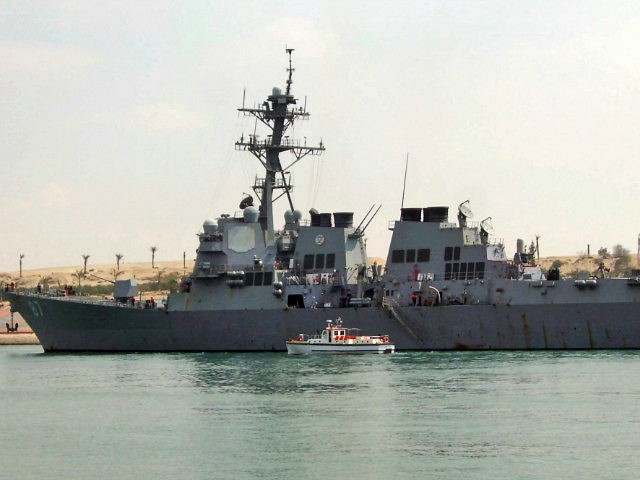The guided-missile destroyer USS Mason was attacked by Iran-backed insurgents in Yemen for a second time on Wednesday, according to U.S. military officials quoted by Time magazine.
The Time report says the attack once again came in the form of two missiles fired from the Yemeni coast. The Mason “used countermeasures, but neither missile got near the ship and there were no injuries.”
USNI News filled in some details of Sunday’s first missile attack, confirming that USS Mason fired three of her own missiles to defend herself and the nearby USS Ponce from the inbound weapons:
Mason launched two Standard Missile-2s (SM-2s) and a single Evolved Seasparrow Missile (ESSM) to intercept the two missiles that were launched about 7 P.M. local time. In addition to the missiles, the ship used its Nulka anti-ship missile decoy, the sources confirmed. Mason was operating in international waters north of the strait of Bab el-Mandeb at the time of the attack.
According to a defense official on Monday, Mason “employed onboard defensive measures” against the first suspected cruise missile, “although it is unclear whether this led to the missile striking the water or whether it would have struck the water anyway.” The official did not specify that the defensive measure was a missile fired from the ship.
USNI News understands, as of Monday, the crew of the ship was uncertain if the suspected cruise missile was taken out by an SM-2 or went into the water on its own. In the Monday statement, the Pentagon said an investigation was ongoing.
Center for Strategic and Budgetary Assessments analyst Bryan Clark told USNI News this might be the first time the SM-2 was “used against an actual threat for which it was designed” and definitely the first battlefield deployment of the ESSM, making the engagement “obviously a huge deal.”
By studying the damage to the United Arab Emirates ship attacked by the Houthi insurgents last week, analysts believe they’re using Chinese-built C-802 anti-ship missiles, identified as “Saccade” missiles under NATO naming conventions. Iran is the primary source for these missiles at present and has been known to supply its proxies in Hezbollah with them.
While the fate of the first missile from Yemen on Sunday is still being investigated, the Pentagon said the second weapon “hit the water without being struck by a U.S. interceptor.” It reportedly flew over 24 nautical miles before splashing down, a troubling display of range.
The Houthis have denied firing on the U.S. Navy, but Reuters reported on Wednesday that American investigators see “growing indications” they were responsible for the Sunday attack.
These officials, speaking anonymously because the investigation is still ongoing, said the rebels “appeared to use small skiffs as spotters to help direct a missile attack on the warship.” There are also indications that a land-based radar station under Houthi control in Yemen “painted” the Mason, relaying its position to the missile crews.
“Anybody who takes action, fires against U.S. Navy ships operating in international waters, does so at their own peril,” Pentagon spokesman Captain Jeff Davis said at a news briefing on Tuesday.

COMMENTS
Please let us know if you're having issues with commenting.